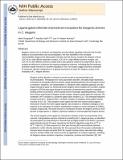| dc.contributor.author | Ringstad, Niels | |
| dc.contributor.author | Abe, Namiko | |
| dc.contributor.author | Horvitz, Howard Robert | |
| dc.date.accessioned | 2014-01-24T18:03:59Z | |
| dc.date.available | 2014-01-24T18:03:59Z | |
| dc.date.issued | 2009-07 | |
| dc.date.submitted | 2008-12 | |
| dc.identifier.issn | 0036-8075 | |
| dc.identifier.issn | 1095-9203 | |
| dc.identifier.uri | http://hdl.handle.net/1721.1/84506 | |
| dc.description.abstract | Biogenic amines such as serotonin and dopamine are intercellular signaling molecules that function widely as neurotransmitters and neuromodulators. We have identified in the nematode Caenorhabditis elegans three ligand-gated chloride channels that are receptors for biogenic amines: LGC-53 is a high-affinity dopamine receptor, LGC-55 is a high-affinity tyramine receptor, and LGC-40 is a low-affinity serotonin receptor that is also gated by choline and acetylcholine. lgc-55 mutants are defective in a behavior that requires endogenous tyramine, which indicates that this ionotropic tyramine receptor functions in tyramine signaling in vivo. Our studies suggest that direct activation of membrane chloride conductances is a general mechanism of action for biogenic amines in the modulation of C. elegans behavior. | en_US |
| dc.description.sponsorship | National Institutes of Health (U.S.) (Grant GM24663) | en_US |
| dc.description.sponsorship | Howard Hughes Medical Institute | en_US |
| dc.description.sponsorship | Life Sciences Research Foundation | en_US |
| dc.description.sponsorship | Medical Foundation, Inc. | en_US |
| dc.language.iso | en_US | |
| dc.publisher | American Association for the Advancement of Science (AAAS) | en_US |
| dc.relation.isversionof | http://dx.doi.org/10.1126/science.1169243 | en_US |
| dc.rights | Creative Commons Attribution-Noncommercial-Share Alike 3.0 | en_US |
| dc.rights.uri | http://creativecommons.org/licenses/by-nc-sa/3.0/ | en_US |
| dc.source | PMC | en_US |
| dc.title | Ligand-Gated Chloride Channels Are Receptors for Biogenic Amines in C. elegans | en_US |
| dc.type | Article | en_US |
| dc.identifier.citation | Ringstad, N., N. Abe, and H. R. Horvitz. “Ligand-Gated Chloride Channels Are Receptors for Biogenic Amines in C. elegans.” Science 325, no. 5936 (July 2, 2009): 96-100. | en_US |
| dc.contributor.department | Massachusetts Institute of Technology. Department of Biology | en_US |
| dc.contributor.department | McGovern Institute for Brain Research at MIT | en_US |
| dc.contributor.mitauthor | Ringstad, Niels | en_US |
| dc.contributor.mitauthor | Abe, Namiko | en_US |
| dc.contributor.mitauthor | Horvitz, H. Robert | en_US |
| dc.relation.journal | Science | en_US |
| dc.eprint.version | Author's final manuscript | en_US |
| dc.type.uri | http://purl.org/eprint/type/JournalArticle | en_US |
| eprint.status | http://purl.org/eprint/status/PeerReviewed | en_US |
| dspace.orderedauthors | Ringstad, N.; Abe, N.; Horvitz, H. R. | en_US |
| dc.identifier.orcid | https://orcid.org/0000-0002-9964-9613 | |
| mit.license | OPEN_ACCESS_POLICY | en_US |
| mit.metadata.status | Complete | |
